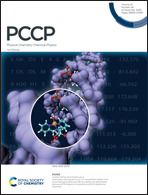Hindered rotor benchmarks for the transition states of free radical additions to unsaturated hydrocarbons†
Abstract
The hindered internal rotors of 32 transition states (TSs) formed through four free radicals, namely methyl, vinyl, ethyl, methoxy (ĊH3, Ċ2H3, Ċ2H5, CH3Ȯ) additions to acetylene, ethylene, allene, propyne, and propene (C2H2/C2H4/C3H4-a/C3H4-p/C3H6) are studied. To validate the uncertainties of rate constants that stem from the use of different electronic structure methods to treat hindered rotors, the rotations of the newly formed C–C and/or C–O rotors in the transition states are calculated using commonly used DFT methods (B3LYP, M06-2X, ωB97X-D and B2PLYP-D3 with two Pople basis sets (6-31+G(d,p), 6-311++G(d,p)) and cc-pVTZ). The hindrance potential energies V(χ) calculated using the M06-2X/6-311++G(d,p) method are benchmarked at the CCSD(T), CCSD(T)-F12, DLPNO-CCSD(T) levels of theory with cc-pVTZ-F12 and cc-pVXZ (X = T, Q) basis sets and are extrapolated to the complete basis set (CBS) limit. The DLPNO-CCSD(T)/CBS method is proven to reproduce the CCSD(T)/CBS energies within 0.5 kJ mol−1 and this method is selected as the benchmark for all of the rotors in this study. Rotational constants B(χ) are computed for each method based on the optimized geometries for the hindrance potential via the I(2,3) approximation. Thereafter, the V(χ) and B(χ) values are used to compute hindered internal rotation partition functions, QHR, as a function of temperature. The uncertainties in the V(χ), B(χ) and QHR calculations stem from the use of different DFT methods for the internal rotor treatment are discussed for these newly formed rotors. For rotors formed by Ṙ + C2 alkenes/alkynes, the V(χ) and QHR values calculated using DFT methods are compared with the DLPNO-CCSD(T)/CBS results and analysed according to reaction types. Based on comparisons of the DFT methods with the benchmarking method, reliable DFT methods are recommended for the treatment of internal rotors for different reaction types considering both accuracy and computational cost. This work, to the authors’ knowledge, is the first to systematically benchmark hindrance potentials which can be used to estimate uncertainties in theoretically derived rate constants arising from the choice of different electronic structure methods.



 Please wait while we load your content...
Please wait while we load your content...